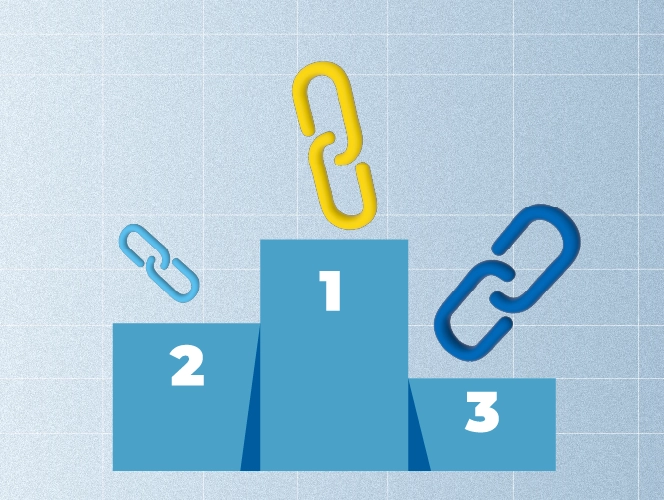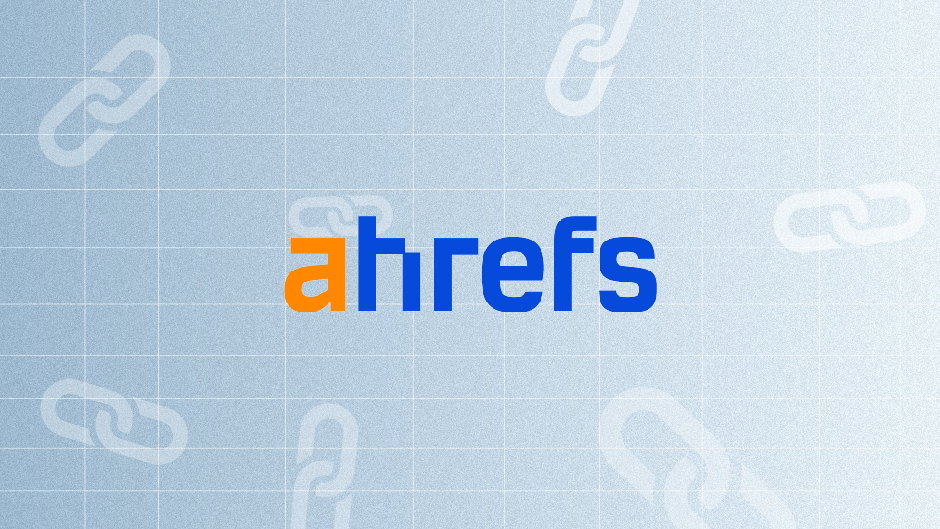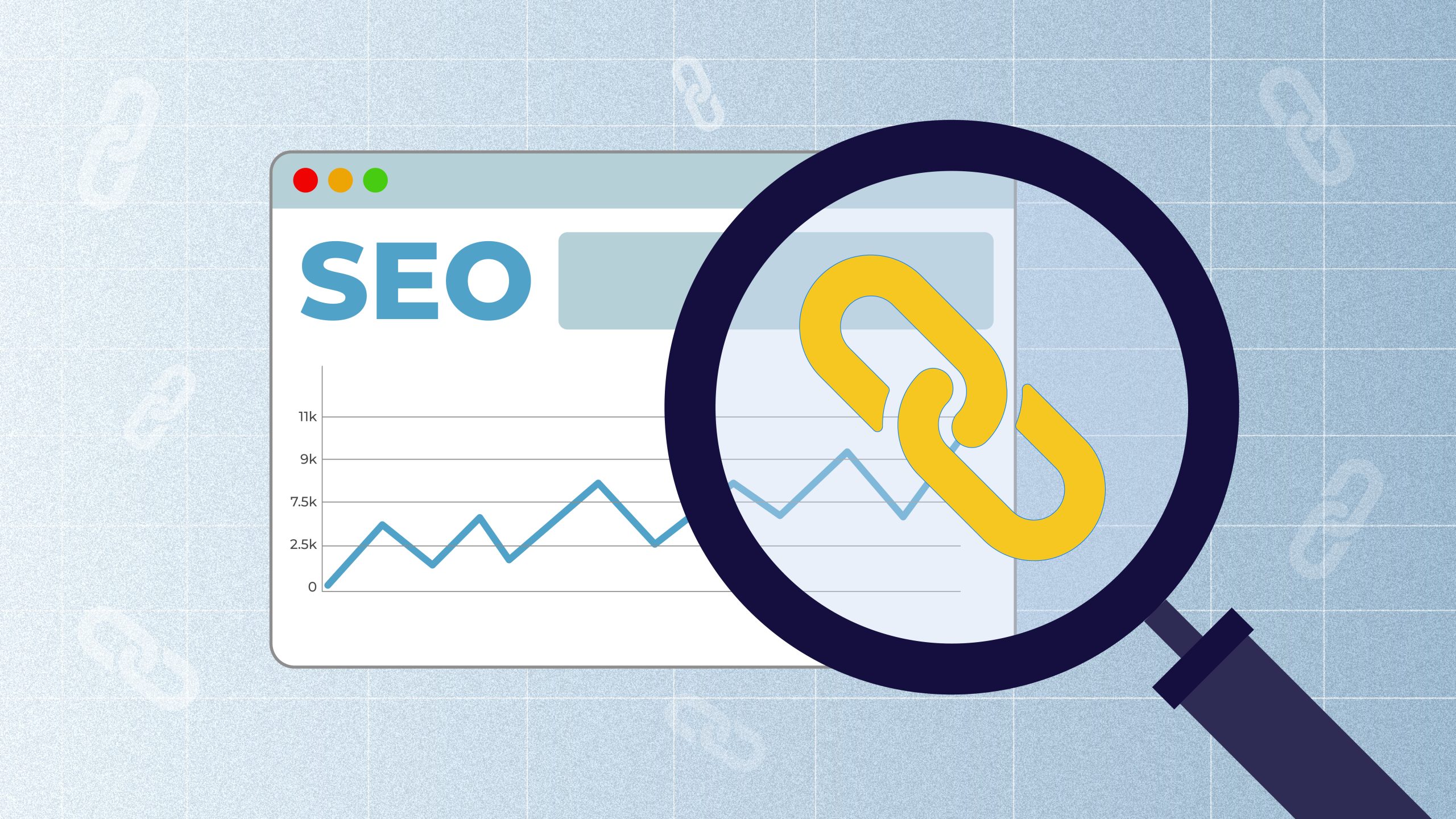Want to know the secret behind top-ranking pages? It’s all about backlinks. And the best way to build your own backlink strategy? Analyzing your competitor’s backlink strategy.
Don’t just take our word for it—studies show that the top-ranking page on Google gets 3.8x more backlinks than others. So, how can you make that power work for you?
In this guide, we’ll show you how to analyze your competitors’ backlinks and use that data to enhance your link building strategy.
Let’s get started!
What is Competitor Backlink Analysis
Competitor backlink analysis is the process of analyzing the links that point to your competitors’ websites to understand how they build their backlink profile.
By discovering the sites that link to your competitors, you can find potential spots for your own backlinks, helping you create a smarter and more effective link building strategy. Further, learning how to manage your backlinks effectively helps you focus on high-quality, authoritative sites, giving you a stronger competitive edge.
Wondering how this can further help your SEO? Let’s break down the rest of the benefits.
3 Key Benefits of Competitor Backlink Analysis
Here’s why analyzing competitor backlinks might just be the missing piece in your SEO strategy.
Exploring New Backlink Opportunities
When you check out your competitors’ backlinks, you can find some amazing opportunities. You see which trustworthy sites are linking to them—websites you might want to get a link from, too.
With tools like a backlink checker, you can easily find these sources. Then, you can reach out to these websites with the right link collaboration offer.
This way, you’re not just building relevant backlinks—you’re also boosting your site’s rankings and credibility.
Improved and Diverse Backlink Profile
Improving your backlink profile starts with looking at your competitors. By checking where they’re getting their best links, you can find new opportunities to level up your own strategy.
But it’s not only about building backlinks. What also matters is variety. When you get links from a range of reputable sites.Google rewards such an approach and pushes you higher in search results. Cool, right?
Learning From Competitors’ Mistakes
By regularly doing competitor backlink analysis, you can track their backlink profiles over time and identify any sudden boosts or drops. Using this info, you can avoid threats and SEO attacks to your own backlink profile.
Basically, you are learning from the mistakes that your competitors are making and are trying to avoid them. By identifying irrelevant or toxic backlinks, you can stay away from those practices and create a stronger backlink profile.
How to Do Competitors Backlink Analysis In 4 Steps
In case you are already convinced that tracking backlinks pointing to your competitors is a beneficial idea, now you may be looking for effective strategies to implement it.
Step 1: Find your main competitors
When starting this process, keep in mind that you need to research two types of competitors: domain-level and page-level.
Domain-level competitors
You compete with your domain-level competitors across their whole domain. These websites categorize within the same niche as yours and typically target the same audience as you.
They not only battle for SERP rankings with you but target similar potential markets and compete with your offers.
To research the domain-level competitors, you must analyze all competing domains’ backlink profiles. In the meantime, check what kind of different competitor analysis tools Ahrefs offers for a more professional approach.
Consider identifying competitors at the domain-level on Ahrefs by following these steps:
Step1: Enter your Ahrefs account
Step2: Search your domain on Ahrefs
Step3: Click on Organic Competitors and see the results.
Let’s take a look at an example with Monday.

These are the domains that exist for the same reason as yours and have the same target goals.
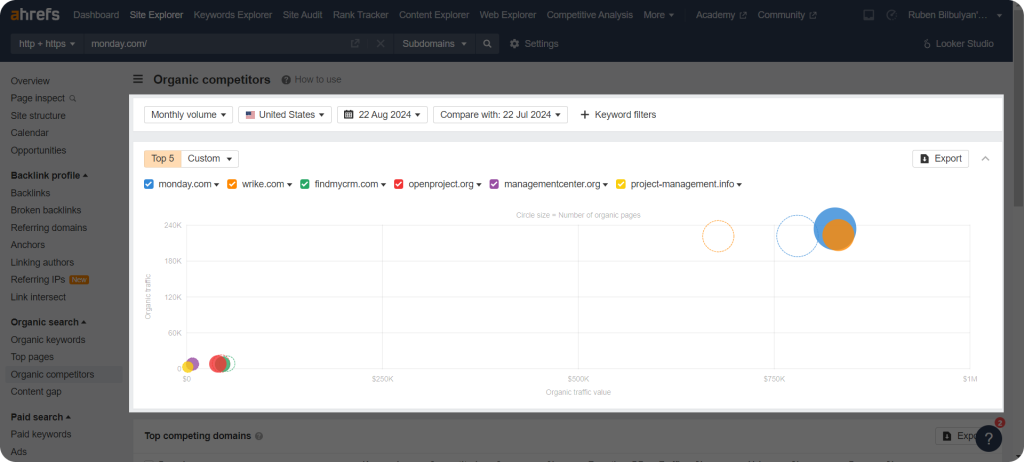
But how different is the second group of competitors?
Page-Level Competitors
On the contrary to domain-level competitors, page-level competitors may not have the same client pool and may not be trying to target the same audience as you.
Instead, the page-level competitor research only looks at the backlinks of a specific page.
And here’s how to find competitors backlinks using Ahrefs:
Step 1: Enter your Ahrefs account
Step 2: Enter the URL of the specific page for which you want to find competitors
Step 3: Choose Exact URL and see the results.
Down below, you can see the pages that compete with the page from Monday.
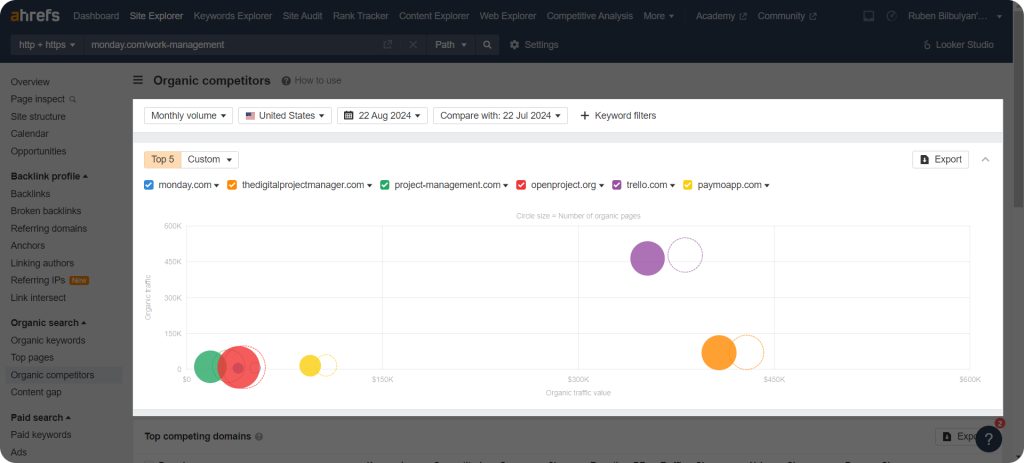
Got the difference?
After identifying competitors and analyzing both types, you should create separate lists for each of them. Next, you need to build unique tactics on how you should try to outrank these two types of competitors.
Step 2: Analyze competitor keywords
Chances are higher that you already have several keywords as an integral part of your link-building strategy. However, your job is to conduct competitor keyword analysis and find new top-performing keywords, so you don’t miss out on valuable opportunities.
And yes, this is an ongoing process.
For that matter, as you have already defined your competitors in your niche, you should look for the anchor texts used for the backlinks linking to their websites. By reviewing Google AI overviews or even performing a simple Google search, you can gain deeper insights into how competitors are utilizing keywords and discover emerging trends that might give you a competitive edge. After that, check the relevance of the keywords used in the anchor texts to your own website.
Without a doubt, you should check the Keyword Difficulty, Search Volume, and other important metrics as well. To simplify this process, link building extensions can help by giving you a quick overview of keyword relevance and competition directly from your browser.
Furthermore, when you conduct competitor keyword analysis pay attention to user intent behind each keyword and highlight the ones that align with your link-building goals.
By understanding the keywords that your competitors target and the websites linking to them, you can find and fill potential gaps in your own link-building strategy.
Step 3: Qualify all of your competitor backlinks
You already did a great job identifying and making a list of your main competitors.
It’s time to do a competitive backlink analysis to uncover opportunities for improving your own backlink profile and SEO strategy because having many backlinks isn’t a sign of their quality.
One of the things to keep in mind is getting valuable SaaS backlinks, as they increase your website traffic faster and give your website more trustworthiness.
What to remember when qualifying competitors backlinks?
Follow several criteria and metrics that will guide you through the process:
✓Keep in mind the domain rating (DR) to find out how strong a site’s backlink profile is. This metric gives an idea of a website’s overall authority in search engine rankings. Ultimately, your goal should be getting backlinks from high DR websites because, considered more valuable and authoritative, they can increase your search engine rankings.
✓ Traffic is another key factor when analyzing competitor backlinks. If a site linking to them gets a lot of visitors, that means more organic visitors and credibility—which is exactly what you want for your own backlinks too!
✓ Check the do follow vs. no follow ratio on sites linking to your competitors. A balanced mix is good, but too many no follows or their complete absence raises red flags.
✓Consider the anchor text to get insight into the keywords your competitors are targeting with their link-building strategy. Analyzing types of anchor text can further reveal how they structure their links for maximum SEO impact.
✓ Keep an eye on backlink placement to ensure your link is visible to website visitors. Not to mention, you should avoid inserting your links in places where there are too many other links.
✓ Backlink relevance is another important factor to consider because you need to add your links on relevant websites. This ensures that their visitors will be interested and will click on your link to get additional information.
✓Look for link gaps to identify domains that link to your competitors but not to your own website, which takes us to the next point.
Step 4: Define competitor backlink gap
Simply put, a link gap is the difference in both the number and quality of backlinks that your competitors have but you don’t.
So backlink gap analysis should be an important part of your competitor backlink analysis. By comparing competitors’ backlink profiles to your own, you can identify sites from where they get backlinks, but you don’t.
In this stage, it’s important to consider the quality and relevance of these backlinks to determine their value.
Let’s discuss this with an example. Assume that hubspot.com wants to find out where its two organic competitors, zapier.com and mailchimp.com, have backlinks that they miss.
Step 1: Log to your Ahrefs account
Step 2: Click on Link Intersect
Step 3: In the section “Show me who is linking to these domains or URLs section” include competitors’ domains (zapier.com and mailchimp.com)
Step 4: In the ”But doesn’t link to section ” include your domain (hubspot.com)
Step 5: Click “Show link opportunities” to perform the backlink gap analysis.
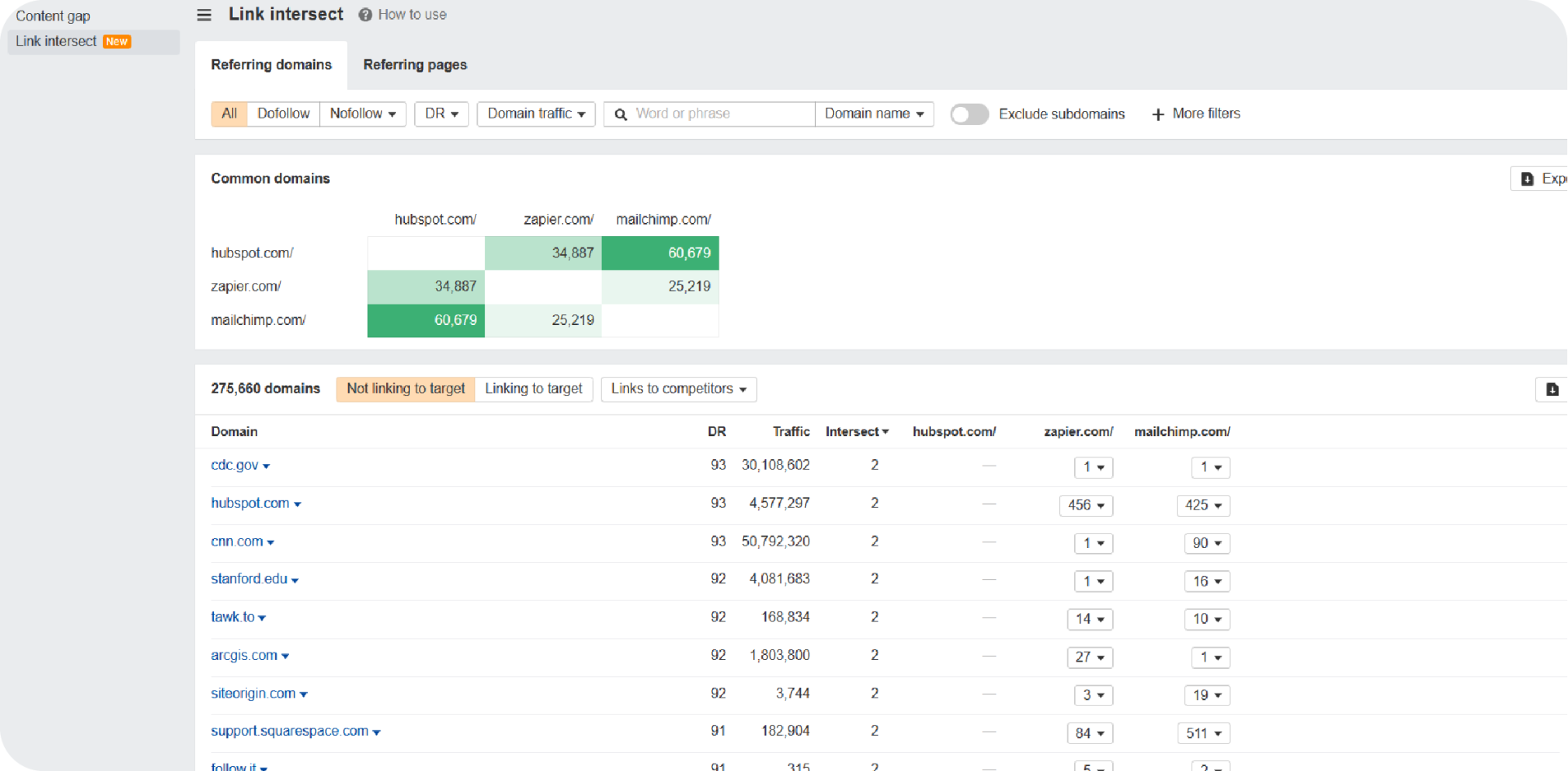
In the next step, check the relevance and authority of those websites that your competitors have backlinks from. Then try to create your own outreach tactics for getting backlinks from those domains as well.
Competitor Backlink Analysis is Done, Now What?
You did an excellent job doing competitive backlink analysis. But you may wonder what’s next and how you can use the collected data to enhance your link-building strategies.
So we will suggest some tactics that will guide you to develop your link-building strategy after this process.
- Make a list of relevant websites where your competitors have backlinks but you don’t, which meet your DR and traffic requirements.
- Analyzing backlinks of competitors to understand which type of content earns links. Generative AI tools can help you to boost the quality of your content and help you to attract backlinks from new and authoritative websites.
- Want to outrank them for a specific keyword? Figure out how many backlinks you’ll need to close the gap. Make sure to track keyword rankings to see if your efforts are delivering results.
- Use what you’ve learned to build a data-backed link building strategy that delivers results.
- Connect with the right sites, offer value, and build those backlinks.
- Monitor results, see what’s working, and adjust your strategy to keep improving.
You’ve got the roadmap—now take the first step and start building stronger backlinks!
3 Competitor Backlink Analysis Tools
We covered almost everything about competitor backlink analysis. But you may wonder what tools are out there that make this process successful and effective. Let’s explore some of the best backlink tools and SEO analytics platforms available for competitive backlink monitoring.
Ahrefs
You’ve probably noticed that we’ve mentioned Ahrefs several times throughout the article. This isn’t surprising because this complete SEO tool is an excellent option for analyzing competitor backlink strategies.
Here are several ways Ahrefs backlink checker can be extremely helpful during this process:
✔ Discover your organic competitors.
✔ Find out and analyze competitors backlinks.
✔ Define the content gap to check which websites link to your competitors but not you.
✔ Identify and qualify the backlinks.
On top of this, Ahrefs Best by Links feature can help you monitor competitors’ backlink profiles and find new link-building opportunities. You can also use Ahrefs to discover backlinks from social bookmarking sites, which are valuable for diversifying your link profile. Here is how you can do that:
Step 1: Log in to Ahrefs and click on Site Explorer.
Step 2: Enter your competitor’s website URL.
Step 3: Go to the Pages section and select Best by Links.
Step 4: In the last step, review the list of top pages with the most backlinks.
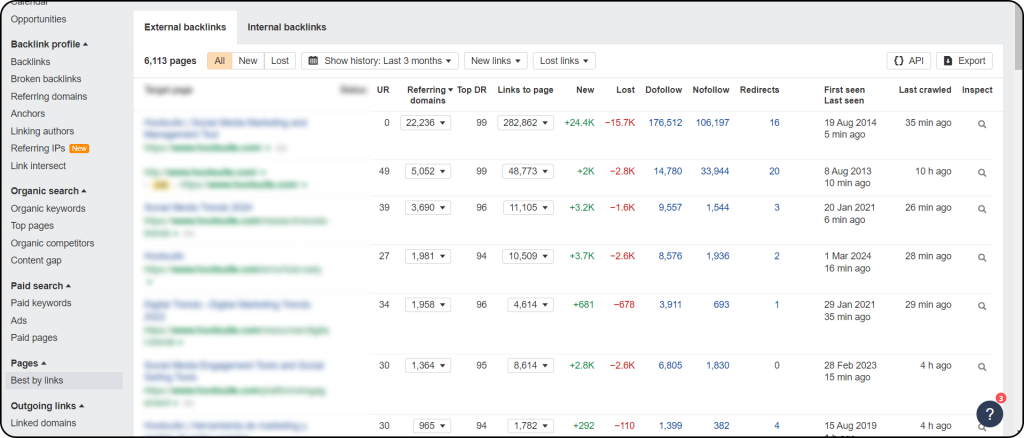
Knowing what types of competitors’ content get the most backlinks allows you to refine your content and link-building strategies.
Ok, to have a clear picture of how you can use Ahrefs for competitive backlink analysis, we should talk about both the advantages and disadvantages of this tool:
Pros
✅ Huge and accurate backlink database
✅ In-depth backlink analysis with Ahrefs Backlink Checker
✅ Unique features
Cons
❌ Not affordable for everyone
❌ Can be a little harder to use for newbies.
❌ Not having a free plan or trial
Once you’ve researched Ahrefs’ pros and cons and decided it’s the tool for you, the next step is to explore its pricing. Let’s get started.
Ahrefs pricing
Lite– starts at$129 /mo
Standard-starts at 249 /mo
Advanced-starts at $449 /m
Enterprise-starts at $14,990 /yr
Semrush
We don’t want to participate in the Semrush vs. Ahrefs debate now. However, we have to start by saying that this tool is also invaluable for competitive analysis. It helps you analyze your competitor’s organic traffic and conduct competitor keyword analysis to find their top-performing keywords. You can also monitor competitor backlink profiles and check their backlinks’ authority and relevance.
Now, let’s discuss how to find and analyze competitor backlinks and find potential link-building opportunities using Semrush.
Step 1: Log in to your SEMrush account.
Step 2: Enter your competitor’s website URL into the search bar.
Step 3: Navigate to the Backlink Analytics section and check the Backlinks tab for a list of backlinks.
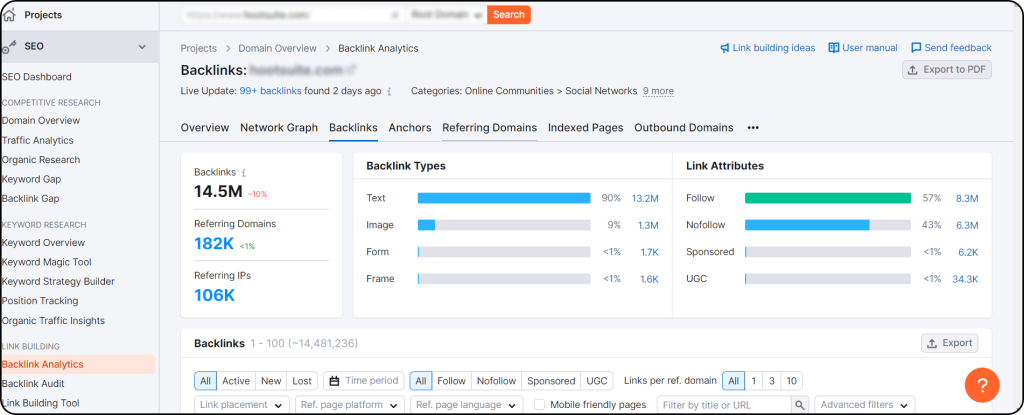
Step 4: Go to the Referring Domains tab to find websites linking to your competitor. You can filter these by data authority score (we choose the form 51-60 option).
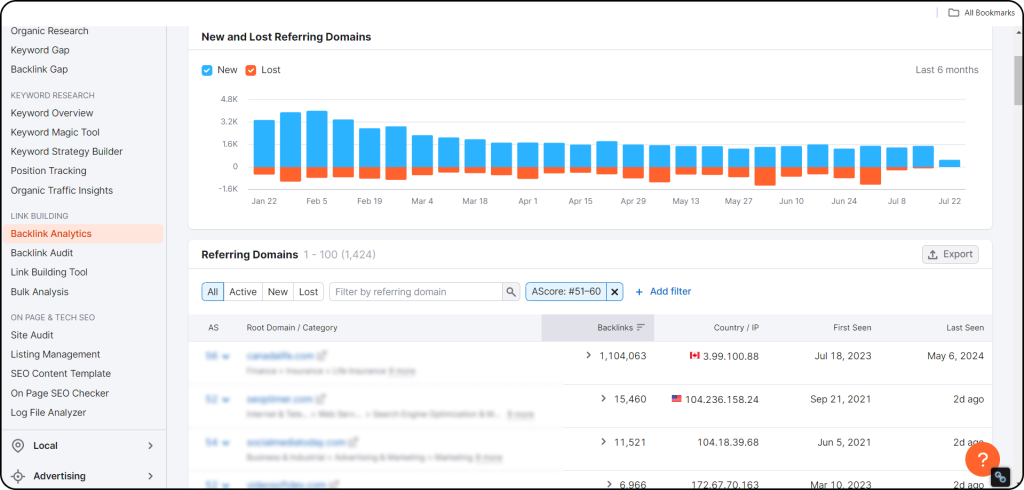
Now you have a list of reputable websites, your competitors have backlinks, and you can have them, too.
We should be fair and speak about the pros and cons of Semrush, as we did for Ahrefs.
Pros
✅ Large and frequently updated backlink database
✅ User-friendly interface
✅ Free plan
Cons
❌ More expensive than Ahrefs
❌ Gives data for only Google
After having all the necessary information, you may prefer Semrush as your SEO analytics tool, you should know about its pricing as well:
Semrush pricing
Pro– $139.95 monthly
Guru– $249.95 monthly
Business– $499.95 monthly
Moz
Moz is another well-known SEO too that can be extremely helpful for competitive backlink analysis. Using its Link Intersect feature, you can find all domains that link to your competitors but not to you.
Here are the exact steps that how you can do that:
Step 1: Enter your domain in the first field of Link Intersect.
Step 2: Add your competitors’ URLs below. You can enter from two to five competitors’ domains.
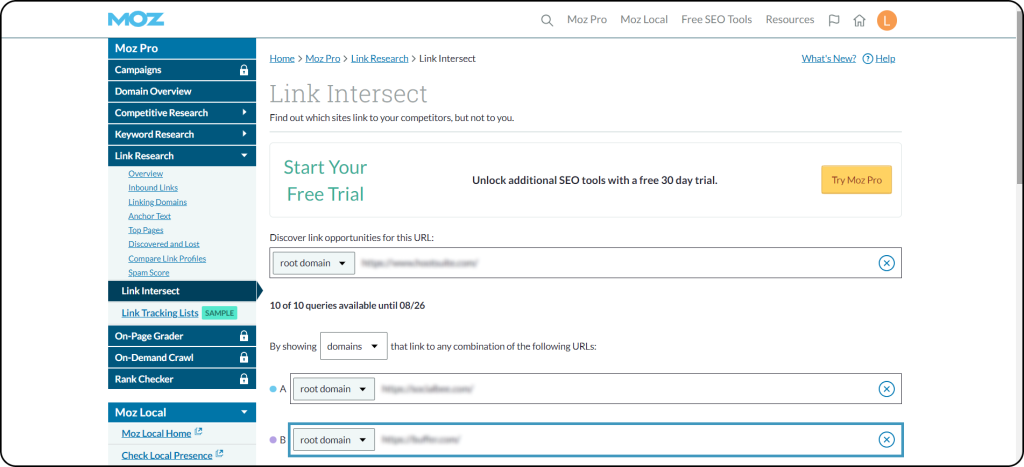
Step 3: Click on the Find opportunities and get a list of domains that link to your competitors, but not to you.
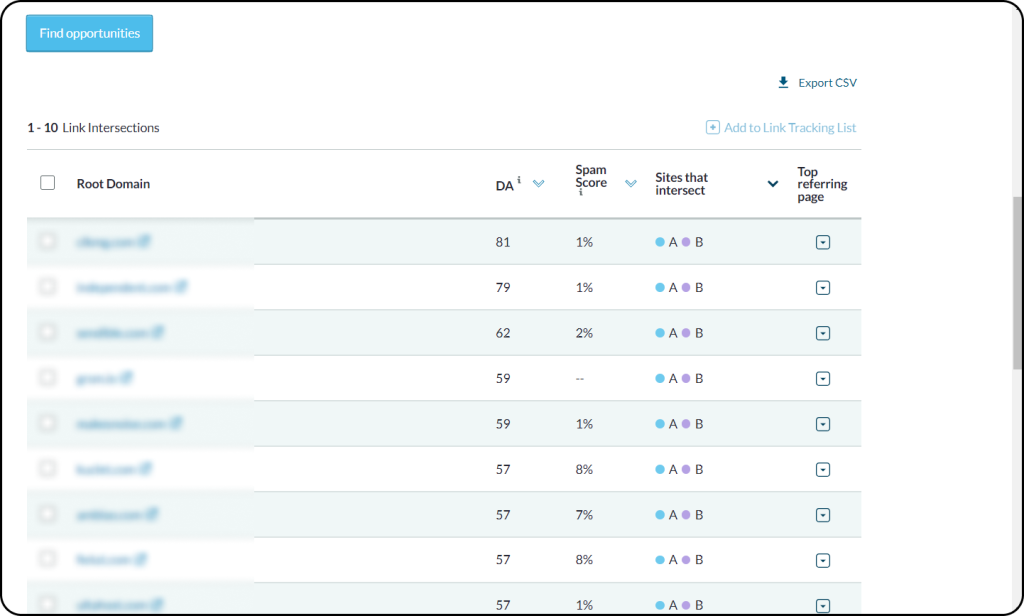
Here is another valuable data you can use to strengthen your backlink profile. You can use the competitor analysis template Moz provides to build an actionable report and spot key opportunities for improvement.
Now, it’s time to discover the advantages and drawbacks Moz has.
Pros
✅Trustworthy and reliable
✅Great balance of features
✅Free Backlink Checking
Cons
❌Limited data compared to Ahrefs or Semrush
❌Data updates are slower than Ahrefs or Semrush
❌Limited free version features
Let’s not break with tradition and present Moz pricing as well.
Moz pricing
Starter-$49USD / mo
Standard-$99USD / mo
Medium-$179USD / mo
Large– $299USD / mo
All these tree tools are great. When choosing which one to use for competitor backlink analysis, start setting your link-building goals and budget. Choose the solution that matches these factors and use its power to grow your backlink profile.
Closing Thoughts
Okay, let’s summarize the key findings about competitor backlink analysis.
- Competitive backlink analysis is the process of analyzing your competitors’ backlinks.
- By monitoring your competitors’ backlinks, you can improve your backlink profile, find new link building opportunities, and more.
- Using Ahrefs backlink checker, SEMrush, Moz, or SEranking you can successfully analyze backlinks of your competitors..
That’s all for now. Thanks for reading.
FAQ about competitor backlink analysis
What are competitor backlinks in SEO?
Competitor backlinks are links from other websites that point to your competitor’s site.
Should you research your competitor backlinks?
Yes. You should research your competitor’s backlinks to find new opportunities to get links from similar sites, improving your SEO.
How do I hide my backlinks from competitors?
It’s impossible to hide your backlinks from competitors, as they can access your backlink profile using SEO tools like Ahrefs and SEMrush.
What is backlink gap in SEO?
A backlink gap is when your competitor has links you don’t have, showing you where you might be missing out on chances to get similar links.

Quiz Time
Let's put your knowledge to the test.
Leave your email below to get a SayNine certificate!
Are you sure?

